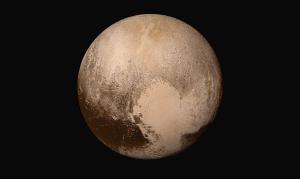Blog
Nitrogen Holds Clues
to Pluto’s Origin
5 June 2018
 NASA/Johns Hopkins University Applied Physics Laboratory/Southwest Research Institute
NASA/Johns Hopkins University Applied Physics Laboratory/Southwest Research InstitutePluto has long been a favorite of astronomy fans. A distant world once thought to mark the outer edge of our solar of our solar system. It has also perplexed astronomers who wondered about its origin.
Unlike the classical planets, Pluto’s orbit is much more elliptical in shape. Only Mercury approaches it in orbital eccentricity. Pluto’s orbit is also tilted away from the plane of other planetary orbits. Because of this, it was once thought that Pluto might have been a moon of Neptune, tossed into deep space by some close approach by a large body. But gravitational simulations tracing planetary motion back in time show there was never a close connection between Neptune and Pluto. Likewise, Pluto did not form closer to the Sun, only move to the outer solar system later.
That left the alternative view that Pluto must have formed out of the icy dust and gas of the Kuiper belt. If this were true, we would expect Pluto to be an old and cold world, without much interior activity. But observations by New Horizons found a rich surface of plains and mountains, showing that Pluto is still and active world. We’re still not sure why Pluto is so active, but a new paper points to one solution.1 Cometary bombardment may have played a large role in Pluto’s formation.
The work looks at the ratio of molecular nitrogen to other compounds such as carbon monoxide in an area on Pluto known as Sputnik Planitia. The low gravity and extremely thin atmosphere of Pluto allows nitrogen to escape the planet’s surface. If Pluto had formed early in the history of the solar system, then the nitrogen level on areas such as Sputnik Planitia should be lower than we observe. It’s possible that geologic activity could replenish the nitrogen, but it would also tend to replenish other elements, and the levels of carbon monoxide are rather low. So the authors propose that Pluto could (at least partly) have formed out of cometary bombardment, which would maintain the planet’s surface nitrogen.
The data we have on Pluto’s chemical composition is relatively sparse, so the idea that Pluto was formed largely from comets is only one possible solution of many. But there is other evidence that points in that direction. For example, Pluto’s orbit has a 3:2 resonance with Neptune, meaning that as Neptune orbits the Sun three times, Pluto orbits the Sun twice. These types of resonances tend to cluster bodies into similar orbits, and in fact we’ve found more than 200 small bodies with a 3:2 resonance similar to Pluto. Collisions with Pluto are therefore more likely than they would be by random chance.
It’s an interesting idea, but it will take much more study to determine if that’s what actually happened.
Glein, Christopher R., and J. Hunter Waite. “Primordial N 2 provides a cosmochemical explanation for the existence of Sputnik Planitia, Pluto.” Icarus 313 (2018): 79-92. ↩︎